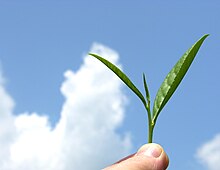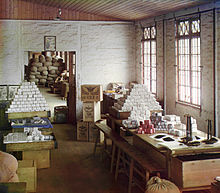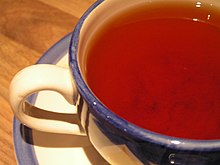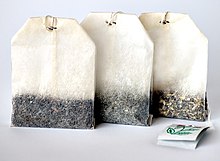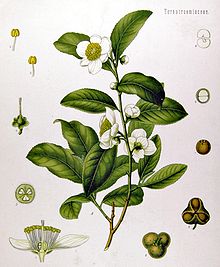
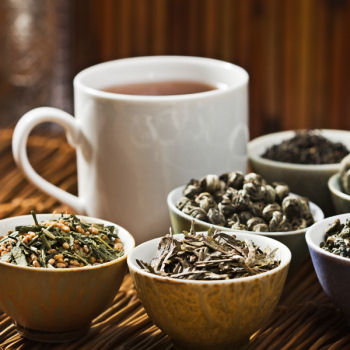

How to Brew the Perfect Cup of Tea
Good water is crucial. Fill an empty kettle with fresh cold water. If using tap water, let the water run for 30 seconds so that it is fresh.
While the water is heating, fill your teapot with hot tap water to preheat it. This prevents cracking that can occur when boiling water is placed in a room temperature pot, and it helps the brewed tea maintain the proper temperature. Discard the water once the pot is warm.
For loose tea, place approximately one teaspoon of tea leaves per cup into the pot, or into an infuser placed in the pot. (The amount depends on the type of tea and personal preference.) If you don't have loose tea, use one tea bag per 1-2 cups, depending on the size of the bag and personal preference.
As soon as the water comes to a boil, remove it from the heat. Over heating the water reduces its oxygen content and causes the tea to taste flat. Immediately pour the water into the pot, cover, and let stand. If using green or white tea, allow the water to cool slightly before pouring onto the leaves (ideal temperature 158 deg.-203 deg. F).
NOTE: At an altitude of 5000 feet, water boils at 202 deg. F instead of 212 deg. F, so you don't need to cool the water much.
How long to steep depends primarily on how strong you like your tea and the type of tea you're using. Do not judge by color because some teas brew light while others brew dark. Small leaves brew more quickly and are usually ready in two to three minutes: medium leaves in three to five minutes: large leaves in six. Most teas will taste bitter if you steep longer than six minutes. If you have used an infuser or tea bags, remove them from the pot when the tea has reached the desired strength. Tea bags steep more quickly because the leaves are finely cut, so don't let them steep too long. You may squeeze the bags gently before removing them from the pot to reduce drips (tea bag squeezers make this very easy).
If you placed loose leaves directly into the pot, you may want to pour the tea into a second warmed pot through a strainer to separate the tea from the leaves. This will prevent the tea from becoming bitter. But if you plan to pour all the tea into cups soon, simply place a strainer over the cup and pour slowly from the original pot.
How to brew the perfect pot of tea (summary)
1. Pick your favorite Thistle Dew Tea add one teaspoonful for each 51/2-ounce cup.
2. Bring freshly drawn, cold tap water to a bubbling boil. Use it when it has just reached the stage of bubbling fiercely.
3. Preheat you teapot.
4. Take the teapot to the kettle; when pouring the boiling water, hold the spout of the kettle near the mouth of the teapot. Both of these operations insure that the water is not permitted to cool down before it hits the tea leaves.
5. Brew tea for three to five minutes, depending on the tea and your taste.
6. Keep the brewing tea hot while infusion take place. Use a teapot cozy not direct heat which could scold the leaves.
7. Separate the spent, infused leaf from the brewed tea. Stir the infusion and serve.
8. Pour the tea. Add sugar, milk, honey or lemon to taste.
9. If you want more tea, brew more tea-but use fresh leaves.
Steeping Information:
Black Tea: 3-5 minutes (one steeping only) *String of pearls* 190-200 degrees
Oolong Tea: 90 seconds to 2 minutes (several steepings) *Fish eyes* 180-200 degrees
Green Tea: 2-3 Minutes (several steepings) column of steam steadily rising 170-180 degrees
Spring (or new) Green Tea: 90 seconds to 2 minutes (several steepings) 160-170 degrees
White Tea: 90 seconds to 2 minutes (several steepings) 160-170 degrees
Pu-erh Tea: 2-5 minutes (many steepings) *Turbulent waters* 200-212 degrees
If your teapot will be sitting for a while with tea in it, use a tea cozy to keep the tea at the proper temperature. There are two types of cozies: an "over the top" cozy sits over the pot and must be removed to pour tea; a serving cozy wraps around the pot, leaving the handle and spout exposed for pouring. Both keep tea hot for long periods, depending on the quality of the cozy. It is important, however, not to use a cozy if there are still tea leaves in the pot, since the excess heat will make the tea taste bitter. Only use a cozy if you have removed the tea leaves.
If you add lemon and sugar to your tea, add the sugar first, since the citric acid from the lemon will prevent the sugar from dissolving. Milk is often used in full-bodied teas such as India and Ceylon teas. There is a debate over whether to add milk to the cup before or after the tea; according to the British Standards Institute, milk should be
placed in the cup first. Don't use cream as
it interferes with the taste of the tea.
To wash your teapot, simply rinse with hot water and turn upside-down to dry. Never put it in the dishwasher or use soap. To remove stains, fill with a solution of two tablespoons of baking soda and boiling water and soak overnight. Then rinse thoroughly and let dry.
What is Tea?
Properly speaking, tea refers to both the leaves of the Camellia Sinensis plant and the beverage brewed from those leaves. Its wide variety of incarnations, such as green, black, oolong and white teas, are created by different processing methods, but all derive ultimately from the same plant. The flavor of tea depends not only upon how the tea was processed, but also upon which part of the world the plant grew, the time of the year the leaves were harvested, what the weather was like that season, the soil conditions, altitude, etc.
Teas may be from one single estate or a blend of several different types of tea from various estates. Single estate teas are often more expensive and have unique characteristics particular to that estate for that season. These teas, not unlike fine wines, will vary from year to year, and when that year's crop has been consumed, it's just gone. One must wait until next season to see if the new crop is as good. Blends, on the other hand, are blended so that each year a similar, reliable taste is produced. While these teas don't have the interesting characteristics of single estate teas, good ones are great every-day teas that you can rely on year after year.
Often teas are blended with other flavorings or scented with various flowers. Rarely are flavored teas produced from single estate teas, as the added flavors can mask the special character of these teas. Jasmine scented teas are an obvious exception.
So called "Herbal Teas" are not properly tea because they do not contain tea leaves, in other words, the leaves of the Camellia Sinensis plant. They are the dried leaves, flowers, or fruit of other various plants, brewed much in the same way as real tea. For the most part, herbals will not contain caffeine and will not get bitter with extended brewing, making them very nice for evenings, traveling or as drinks for children or those with an intolerance to caffeine. Generally mild and sweet, these also tend to make terrific iced beverages. Unlike tea, the "leaves" are not light-sensitive, so they can be stored in glass containers to show off their beauty.
Black Teas:
Black teas are produced by a process that includes oxidation sometimes also called fermentation. Black teas are first withered by allowing the moisture in the leaves to evaporate somewhat so that the leaves become pliable. This process takes 12-18 hours. The leaves are then rolled to bruise and damage them, allowing the enzymes in the leaf to come to the surface. Then the leaves are spread out, exposed to the air, in humid rooms. Oxygen reacts with the enzymes on the surface of the leaves and causes them to turn black, thus changing the color and taste of the brewed tea. To stop the oxidation process at the right time, the leaves are finally fired in ovens,, destroying the enzymes responsible for oxidation.
Green Teas:
Green teas are produced by a process that does not include oxidation. Some green teas are steamed initially to kill the leaf (sencha, gyokuro). Most are first withered by simply letting some of the leaves' moisture evaporate, making the leaf pliable. Then the leaves are usually fired in a hot wok to destroy enzymes in the leaf, which prevents the oxidation process from beginning. During firing, the leaves can be shaped in the wok into the desired form, such as the flattened leaves of Dragon Well or the small pellets of gunpowder tea. Some teas are then roasted (hojicha) to produce a toasty flavor.
White Teas:
White teas are appreciated by connoisseurs for their unmatched subtlety, complexity, and natural sweetness. The most delicate of teas, white teas are minimally processed. They are simply steamed, then dried, without significantly altering the leaf. Consequently, these teas appear light and fluffy and require more room to infuse than other teas. Most brew to a very light straw color liquor, hence the name, "white". Use either a large infuser or put the leaves loose in your pot or cup.
Oolong Teas:
In contrast to black and green teas, oolongs are semi-oxidized. Like black teas, oolongs are first withered for several hours to soften the leaves. Then the leaves are alternately oxidized and fired several times by various methods, which may include shaking in baskets or walking on the leaves that have been placed in cloth bags. When the desired amount of oxidation is reached, which can vary significantly, the leaves are fired at high temperatures to destroy the enzymes that contribute to oxidation. Because some oolongs are more oxidized than others, the flavor of oolongs can vary from near-black to quite green. The best oolongs are still all hand-made and have a lovely fruity-flowery aroma and a delicate sweetness.
Herbal and other infusions:
Rooibos: ("roy bus") is made from th needle-like leaves of a caffeine-free bush native to South Africa. It is oxidized like black tea, and many people are using it instead of decaffeinated black teas. Good both hot and cold, it has a mild flavor and won't turn bitter with extended brewing. Known for its soothing properties, it is even higher in antioxidants than green tea. Steep 1 teaspoon of rooibos per cup in freshly boiled water for 5-10 minutes.
Fruit Blends: These are simply dried fruits with various flowers, spices, or natural flavors added. These are great iced, and children love them for tea parties. Use a heaping teaspoon of fruit blends per cup and steep in freshly boiled water for 5-7 minutes or to taste. These will not get bitter with extended brewing.
Herbal Blends: These are simply traditional dried herbs and flowers with bits of fruits or other natural flavors. Refreshing, light and delicious, these make great iced teas as well.
Tea 101
Tea is the agricultural product of the leaves, leaf buds, and internodes of various cultivars and sub-varieties of the Camellia sinensis plant, processed and cured using various methods. "Tea" also refers to the aromatic beverage prepared from the cured leaves by combination with hot or boiling water, and is the common name for the Camellia sinensis plant itself. After water, tea is the most widely consumed beverage in the world. It has a cooling, slightly bitter, astringent flavour which many enjoy.
The term herbal tea usually refers to infusions of fruit or herbs containing no actual tea, such as rosehip tea or chamomile tea. Alternative terms for this are tisane or herbal infusion, both bearing an implied contrast with tea. This article is concerned exclusively with preparations and uses of the tea plant, Camellia sinensis, the Minnan word for which is the etymological origin of the English word tea.
Cultivation and harvesting
Camellia sinensis is an evergreen plant that grows mainly in tropical and sub-tropical climates. Nevertheless, some varieties can also tolerate marine climates and are cultivated as far north as Pembrokeshire in the British mainland and Washington in the United States.Tea plants are propagated from seed or by cutting; it takes approximately 4 to 12 years for a tea plant to bear seed, and about 3 years before a new plant is ready for harvesting. In addition to a zone 8 climate or warmer, tea plants require at least 127 cm. (50 inches) of rainfall a year and prefer acidic soils. Traditional Chinese Tea Cultivation and Studies believes that high-quality tea plants are cultivated at elevations of up to 1,500 metres (4,900 ft): at these heights, the plants grow more slowly and acquire a better flavour.
Only the top 1-2 inches of the mature plant are picked. These buds and leaves are called flushes. A plant will grow a new flush every seven to fifteen days during the growing season, and leaves that are slow in development always produce better flavored teas.
A tea plant will grow into a tree of up to 16 metres (52 ft) if left undisturbed, but cultivated plants are pruned to waist height for ease of plucking.
Two principal varieties are used: the China plant (C. sinensis sinensis), used for most Chinese, Formosan and Japanese teas (but not Pu-erh); and the clonal Assam tea plant (C. sinensis assamica), used in most Indian and other teas (but not Darjeeling). Within these botanical varieties, there are many strains and modern Indian clonal varieties. Leaf size is the chief criterion for the classification of tea plants, with three primary classifications being: Assam type, characterized by the largest leaves; China type, characterized by the smallest leaves; and Cambod, characterized by leaves of intermediate size.
Processing and classification
There are at least six varieties of tea: white, yellow, green, oolong, black, and post-fermented teas of which the most commonly found on the market are white, green, oolong, and black. Some varieties, such as traditional oolong tea and Pu-erh tea, a post-fermented tea, can be used medicinally.
A tea's type is determined by the processing which it undergoes. Leaves of Camellia sinensis soon begin to wilt and oxidize, if not dried quickly after picking. The leaves turn progressively darker as their chlorophyll breaks down and tannins are released. This enzymatic oxidation process, known as fermentation in the tea industry, is caused by the plant's intracellular enzymes and causes the tea to darken. In tea processing, the darkening is stopped at a predetermined stage by heating, which deactivates the enzymes responsible. In the production of black teas, the halting of oxidization by heating is carried out simultaneously with drying.
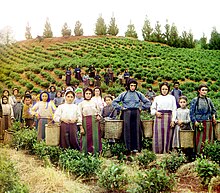
Without careful moisture and temperature control during manufacture and packaging, the tea may become unfit for consumption, due to the growth of undesired molds and bacteria. At minimum it may alter the taste and make it undesirable.
Tea is traditionally classified based on the techniques with which it is produced and processed.
- White tea: Wilted and unoxidized
- Yellow tea: Unwilted and unoxidized, but allowed to yellow
- Green tea: Unwilted and unoxidized
- Oolong: Wilted, bruised, and partially oxidized
- Black tea: Wilted, sometimes crushed, and fully oxidized
- Post-fermented tea: Green tea that has been allowed to ferment/compost
Blending and additives
Although single estate teas are available, almost all teas in bags and most other teas sold in the West are blends. Blending may occur in the tea-planting area (as in the case of Assam), or teas from many areas may be blended. The aim of blending is to obtain better taste, higher price, or both, as a more expensive, better-tasting tea may cover the inferior taste of cheaper varieties.
Some teas are not pure varieties, but have been enhanced through additives or special processing. Tea is highly receptive to inclusion of various aromas; this may cause problems in processing, transportation, and storage, but also allows for the design of an almost endless range of scented and flavored variants, such as bergamot (Earl Grey), vanilla, caramel, and many others.
Content
Tea contains catechins, a type of antioxidant. In a freshly picked tea leaf, catechins can compose up to 30% of the dry weight. Catechins are highest in concentration in white and green teas, while black tea has substantially fewer due to its oxidative preparation. Research by the U.S. Department of Agriculture has suggested that levels of antioxidants in green and black tea do not differ greatly, with green tea having an oxygen radical absorbance capacity (ORAC) of 1253 and black tea an ORAC of 1128 (measured in μmolTE/100g). Tea also contains theanine and the stimulant caffeine at about 3% of its dry weight, translating to between 30 mg and 90 mg per 8 oz (250 ml) cup depending on type, brand and brewing method. Tea also contains small amounts of theobromine and theophylline. Due to modern day environmental pollution fluoride and aluminum have also been found to occur in tea, with certain types of brick tea made from old leaves and stems having the highest levels. This occurs due to the tea plant's high sensitivity to and absorption of environmental pollutants.
Certain tea has more caffeine by weight than coffee; nevertheless, more dried coffee is used than dry tea in preparing the beverage, which means that a cup of brewed tea contains significantly less caffeine than a cup of coffee of the same size.
Tea has negligible carbohydrates, fat, and protein.
Although tea contains various types of polyphenols and tannin, tea does not contain tannic acid. Tannic acid is not an appropriate standard for any type of tannin analysis because of its poorly defined composition.
Origin and history
Tea plants are native to East and South Asia and probably originated around the point of confluence of the lands of northeast India, north Burma, southwest China, and Tibet. Although tales exist in regard to the beginnings of tea being used as a beverage, no one is sure of its exact origins. The usage of tea as a beverage was first recorded in China, with the earliest records of tea consumption with records dating back to the 10th century BC. It was already a common drink during Qin Dynasty (around 200 BC) and became widely popular during Tang Dynasty, when it was spread to Korea and Japan. Trade of tea by the Chinese to Western nations in the 19th century spread tea and the tea plant to numerous locations around the world.
Tea was imported to Europe during the Portuguese expansion of the 16th century, at which time it was termed chá. In 1750, tea experts traveled from China to the Azores Islands, and planted tea, along with jasmines and mallows, to give the tea aroma and distinction. Both green tea and black tea continue to grow in the islands, that are the main supplier to continental Portugal. Catherine of Braganza, wife of Charles II, took the tea habit to Great Britain around 1660, but it was not until the 19th century Britain that tea became as widely consumed as it is today. In Ireland, tea had become an everyday beverage for all levels of society by the late 19th century, but it was first consumed as a luxury item on special occasion such as religious festivals, wakes, and domestic work gatherings such as quiltings.
Health effects
The health benefits of tea is a controversial topic with many proponents and detractors. An article from the journal Nutrition (1999, pp. 946–949) states:
The possible beneficial effects of tea consumption in the prevention of cancer and cardiovascular diseases have been demonstrated in animal models and suggested by studies in vitro. Similar beneficial effects, however, have not been convincingly demonstrated in humans: beneficial effects have been demonstrated in some studies but not in others. If such beneficial effects do exist in humans, they are likely to be mild, depending on many other lifestyle-related factors, and could be masked by confounding factors in certain populations. Another concern is that the amounts of tea consumed by humans are lower than the doses required for demonstrating the disease-prevention effects in animal models. Caution should be applied, however, in the use of high concentrations of tea for disease prevention. Ingestion of large amounts of tea may cause nutritional and other problems because of the caffeine content and the strong binding activities of tea polyphenols, although there are no solid data on the harmful effects of tea consumption. More research is needed to elucidate the biologic activities of green and black tea and to determine the optimal amount of tea consumption for possible health-beneficial effects.
In 2010, researchers found that people who consumed tea had significantly less cognitive decline than non-tea drinkers. The study used data on more than 4,800 men and women aged 65 and older to examine change in cognitive function over time. Study participants were followed for up to 14 years for naturally-occurring cognitive decline. (AAICAD 2010; Lenore Arab, PhD; UCLA)
Several of the potential health benefits proposed for tea are outlined in this excerpt from Mondal (2007, pp. 519–520) as following:
Tea leaves contain more than 700 chemicals, among which the compounds closely related to human health are flavanoides, amino acids, vitamins (C, E and K), caffeine and polysaccharides. Moreover, tea drinking has recently proven to be associated with cell-mediated immune function of the human body. Tea plays an important role in improving beneficial intestinal microflora, as well as providing immunity against intestinal disorders and in protecting cell membranes from oxidative damage. Tea also prevents dental caries due to the presence of fluorine. The role of tea is well established in normalizing blood pressure, lipid depressing activity, prevention of coronary heart diseases and diabetes by reducing the blood-glucose activity. Tea also possesses germicidal and germistatic activities against various gram-positive and gram negative human pathogenic bacteria. Both green and black tea infusions contain a number of antioxidants, mainly catechins that have anti-carcinogenic, anti-mutagenic and anti-tumoric properties.
In a large study of over 11,000 Scottish men and women completed in 1993 and published in the 1999 Journal of Epidemiology and Community Health (1999, pp. 481–487), there was an increase in the risk of coronary disease with the regular consumption of tea, although it disappeared after adjustment for confounding factors (age and occupational status).
The IARC list teas as under Group 3 carcinogens since injection of black tea concentrates under the skins of mice showed some cancerous growths. However, it has not been possible to prove that tea affects humans in similar ways through consumption.
Consumption of some forms of tea has the potential to result in acute liver damage in some individuals. Several herbal and dietary supplements have been linked to liver damage, caused in part or completely by the presence of green tea extract in these supplements; the most notable cases include Hydroxycut (415 mg of a mixture of green, white, and oolong tea extracts, and several other herbal extracts, per dose); Exolise (360 mg of green tea extract per dose); and Tealine (250 mg of green tea extract per dose). These concerns resulted in withdrawals of the first two products and a class action lawsuit against the manufacturer of Hydroxycut. The risk is thought to be quite small: in case of Hydroxycut, 9 million bottles were sold in the U.S. over the lifetime of the product, resulting in 23 known severe cases, however, these included at least one fatality and at least three cases of liver failure resulting in a liver transplantation. In case of Exolise, the risk of an adverse effect was estimated as less than 1 per 100,000.
Tea culture
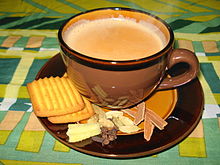
In many cultures, tea is often had at high class social events, such as afternoon tea and the tea party. It may be consumed early in the day to heighten alertness; it contains theophylline and bound caffeine(sometimes called "theine"), although there are also decaffeinated teas.
Tea is prevalent in most cultures in the Middle East. In Arab culture, tea is a focal point for social gatherings. In Iranian (Persian) and Pakistani cultures, tea is so widely consumed that it is generally the first thing offered to a household guest.
In Pakistan, both black and green teas are popular and are known locally as "sabz chai" and "kahwah," respectively. The popular green tea called kahwah is often served after every meal in Khyber Pakhtunkhwa and the Pashtun belt of Balochistan. In the Kashmir region of Pakistan, Kashmiri chai or "noon chai," a pink, milky tea with pistachios and cardamom, is consumed primarily at special occasions, weddings, and during the winter months when it is sold in many kiosks. In the northern Pakistan regions of Chitral and Gilgit-Baltistan, a salty, buttered Tibetan-style tea is consumed.
There are tea ceremonies which have arisen in different cultures, such as the Chinese and Japanese tea ceremonies, each of which employs traditional techniques and ritualized protocol of brewing and serving tea for enjoyment in a refined setting. One form of Chinese tea ceremony is the Gongfu tea ceremony, which typically uses small Yixing clay teapots and oolong tea.
The American poet Wallace Stevens, a tea-fancier, is credited by Eleanor Cook with a "delicately implicit trope of drinking tea as a metaphor for reading (ingesting a drink from leaves)." See for instance his "Tea".
In the United States and Canada, 80% of tea is consumed cold, as iced tea.
In India, tea is one of the most popular hot beverages. It is consumed daily in almost all homes, offered to guests, consumed in high amounts in domestic and official surroundings and is made with the addition of a lot of milk with or without spices. It is also served with biscuits which are dipped in the tea and eaten before consuming the tea.
Preparation
The traditional method of making a cup of tea is to place loose tea leaves, either directly or in a tea infuser, into a tea pot or teacup and pour hot water over the leaves. After a couple of minutes the leaves are usually removed again, either by removing the infuser, or by straining the tea while serving.
Most green teas should be allowed to steep for about two or three minutes, although some types of tea require as much as ten minutes, and others as little as thirty seconds. The strength of the tea should be varied by changing the amount of tea leaves used, not by changing the steeping time. The amount of tea to be used per amount of water differs from tea to tea but one basic recipe may be one slightly heaped teaspoon of tea (about 5 ml) for each teacup of water (200–240 ml) (7–8 oz) prepared as above. Stronger teas, such as Assam, to be drunk with milk are often prepared with more leaves, and more delicate high grown teas such as a Darjeeling are prepared with a little less (as the stronger mid-flavors can overwhelm the champagne notes).
The best temperature for brewing tea depends on its type. Teas that have little or no oxidation period, such as a green or white tea, are best brewed at lower temperatures, between 65 and 85 °C (149 and 185 °F), while teas with longer oxidation periods should be brewed at higher temperatures around 100 °C (212 °F). The higher temperatures are required to extract the large, complex, flavorful phenolic molecules found in fermented tea, although boiling the water reduces the amount of dissolved oxygen in the water.
| Type | Water Temp. | Steep Time | Infusions |
|---|---|---|---|
| White Tea | 65 to 70 °C (149 to 158 °F) | 1–2 minutes | 3 |
| Yellow Tea | 70 to 75 °C (158 to 167 °F) | 1–2 minutes | 3 |
| Green Tea | 75 to 80 °C (167 to 176 °F) | 1–2 minutes | 4-6 |
| Oolong Tea | 80 to 85 °C (176 to 185 °F) | 2–3 minutes | 4-6 |
| Black Tea | 99 °C (210 °F) | 2–3 minutes | 2-3 |
| Pu'er Tea | 95 to 100 °C (203 to 212 °F) | Limitless | Several |
| Herbal Tea | 99 °C (210 °F) | 3–6 minutes | Varied |
Some tea sorts are often brewed several times using the same tea leaves. Historically, in China, tea is divided into a number of infusions. The first infusion is immediately poured out to wash the tea, and then the second and further infusions are drunk. The third through fifth are nearly always considered the best infusions of tea, although different teas open up differently and may require more infusions of hot water to produce the best flavor.
One way to taste a tea, throughout its entire process, is to add hot water to a cup containing the leaves and after about 30 seconds to taste the tea. As the tea leaves unfold (known as "The Agony of the Leaves") they give up various parts of themselves to the water and thus the taste evolves. Continuing this from the very first flavours to the time beyond which the tea is quite stewed will allow an appreciation of the tea throughout its entire length.
Black tea
In the West, water for black tea is usually added near boiling point, at around 99 °C (210 °F). Many of the active substances in black tea do not develop at temperatures lower than 90 °C (194 °F). Lower temperatures are used for some more delicate teas. The temperature will have as large an effect on the final flavor as the type of tea used. The most common fault when making black tea is to use water at too low a temperature. Since boiling point drops with increasing altitude, it is difficult to brew black tea properly in mountainous areas. It is also recommended that the teapot be warmed before preparing tea, easily done by adding a small amount of boiling water to the pot, swirling briefly, before discarding. In the West, black teas are usually brewed for about 4 minutes and are usually not allowed to steep for less than 30 seconds or more than about five minutes (a process known as brewing or mashing in Britain). In many regions of the world, however, boiling water is used and the tea is often stewed. For example, in India black tea is often boiled for fifteen minutes or longer as a strong brew is preferred for making Masala chai. When the tea has brewed long enough to suit the tastes of the drinker, it should be strained while serving. The popular varieties of black (red) tea include Assam tea, Nepal tea, Darjeeling tea, Nilgiri tea, Turkish tea and Ceylon tea.
Green tea
Water for green tea, according to regions of the world that prefer mild tea, should be around 80 to 85 °C (176 to 185 °F); the higher the quality of the leaves, the lower the temperature. Hotter water will produce a bitter taste. However, this is the method used in many regions of the world, such as North Africa or Central Asia where bitter tea is appreciated. For example, in Morocco green tea is steeped in boiling water for fifteen minutes. In the West and Far East a milder tea is appreciated. The container in which the tea is steeped, the mug, or teapot is often warmed beforehand so that the tea does not immediately cool down. High-quality green and white teas can have new water added as many as five or more times, depending on variety, at increasingly high temperatures.
Oolong tea
Oolong teas should be brewed around 90 to 100 °C (194 to 212 °F), and again the brewing vessel should be warmed before pouring in the water. Yixing purple clay teapots are the traditional brewing-vessel for oolong tea. For best results use spring water, as the minerals in spring water tend to bring out more flavor in the tea. High quality oolong can be brewed multiple times from the same leaves, and unlike green tea it improves with reuse. It is common to brew the same leaves three to five times, the third steeping usually being the best.
Premium or delicate tea
Some teas, especially green teas and delicate oolong teas, are steeped for shorter periods, sometimes less than 30 seconds. Using a tea strainer separates the leaves from the water at the end of the brewing time if a tea bag is not being used. However, the black Darjeeling tea, a premium Indian tea, needs a longer than average steeping time. Elevation and time of harvest offer varying taste profiles; proper storage and water quality also have a large impact on taste.
Pu-erh tea
Pu-erh tea is also called Pu'er tea. Pu-erh teas require boiling water for infusion. Some prefer to quickly rinse pu-erh for several seconds with boiling water to remove tea dust which accumulates from the aging process, then infuse it at the boiling point (100°C or 212°F), and allow it to steep from 30 seconds to five minutes.
Serving
In order to preserve the pre-tannin tea without requiring it all to be poured into cups, a second teapot may be used. The steeping pot is best unglazed earthenware; Yixing pots are the best known of these, famed for the high quality clay from which they are made. The serving pot is generally porcelain, which retains the heat better. Larger teapots are a post-19th century invention, as tea before this time was very rare and very expensive. Experienced tea-drinkers often insist that the tea should not be stirred around while it is steeping (sometimes called winding in the UK). This, they say, will do little to strengthen the tea, but is likely to bring the tannins out in the same way that brewing too long will do. For the same reason one should not squeeze the last drops out of a teabag; if stronger tea is desired, more tea leaves should be used.
Additives
The addition of milk to tea in Europe was first mentioned in 1680 by the epistolist Madame de Sévigné. Many teas are traditionally drunk with milk in cultures where dairy products are consumed. These include Indian masala chai, and British tea blends. These teas tend to be very hearty varieties of black tea which can be tasted through the milk, such as Assams, or the East Friesian blend. Milk is thought to neutralize remaining tannins and reduce acidity. The Han Chinese do not usually drink milk with tea (or indeed use milk at all) but the Manchus do, and the elite of the Qing Dynasty of the Chinese Empire continued to do so. Hong Kong-style milk tea is based on British colonial habits. Tibetans and other Himalayan peoples traditionally drink tea with milk or yak butter and salt. In Eastern European countries (Russia, Poland and Hungary) and Italy people commonly have their tea with lemon juice. In Poland, tea with milk is called a bawarka ("Bavarian style"), and is often drunk by pregnant and nursing women.
The order of steps in preparing a cup of tea is a much-debated topic.
Some say that it is preferable to add the milk before the tea, as the
high temperature of freshly brewed tea can denature the proteins found
in fresh milk, similar to the change in taste of UHT milk, resulting in an inferior tasting beverage.
Others insist that it is better to add the milk after brewing the tea,
as most teas need to be brewed as close to boiling as possible. The
addition of milk chills the beverage during the crucial brewing phase,
if brewing in a cup rather than using a pot, meaning that the delicate
flavor of a good tea cannot be fully appreciated. By adding the milk
afterwards, it is easier to dissolve sugar in the tea and also to ensure
that the desired amount of milk is added, as the color of the tea can
be observed.
A 2007 study published in the European Heart Journal found that certain beneficial effects of tea may be lost through the addition of milk.[49]
Many flavourings are added to varieties of tea during processing. Among the best known are Chinese Jasmine tea, with jasmine oil or flowers, the spices in Indian Masala chai and Earl Grey tea, which contains oil of bergamot. A great range of modern flavours have been added to these traditional ones.In eastern India people also drink lemon tea or lemon masala tea. Lemon tea simply contains hot tea with lemon juice and sugar. Masala lemon tea contains hot tea with roasted cumin seed powder,lemon juice,black salt and sugar which gives it a tangy, spicy taste.
Other popular additives to tea by the tea-brewer or drinker include sugar, liquid honey or a solid Honey Drop, agave nectar, fruit jams, and mint. In China sweetening tea was traditionally regarded as a feminine practice. In colder regions such as Mongolia, Tibet and Nepal, butter is added to provide necessary calories. Tibetan butter tea contains rock salt and dre (yak) butter, which is then churned vigorously in a cylindrical vessel closely resembling a butter churn. The same may be said for salt tea, which is consumed in some cultures in the Hindu Kush region of northern Pakistan.
Alcohol may also be added to tea, such as whisky or brandy.
The flavor of the tea can also be altered by pouring it from different heights, resulting in varying degrees of oxidization. The art of high-altitude pouring is used principally by people in Northern Africa (e.g. Morocco, Algeria, Mauritania and Libya), but also in West Africa (e.g. Guinea, Mali, Senegal) and can positively alter the flavor of the tea, but it is more likely a technique to cool the beverage destined to be consumed immediately. In certain cultures the tea is given different names depending on the height it is poured from. In Mali, gunpowder tea is served in series of three, starting with the highest oxidization or strongest, unsweetened tea (cooked from fresh leaves), locally referred to as "bitter as death," followed by a second serving, where the same tea leaves are boiled again with some sugar added ("pleasant as life"), and a third one, where the same tea leaves are boiled for the third time with yet more sugar added ("sweet as love"). Green tea is the central ingredient of a distinctly Malian custom, the "Grin," an informal social gathering that cuts across social and economic lines, starting in front of family compound gates in the afternoons and extending late into the night, and is widely popular in Bamako and other large urban areas.
In Southeast Asia, particularly in Malaysia, the practice of pouring tea from a height has been refined further using black tea to which condensed milk is added, poured from a height from one cup to another several times in alternating fashion and in quick succession, to create a tea with entrapped air bubbles creating a frothy "head" in the cup. This beverage, teh tarik, literally, "pulled tea," has a creamier taste than flat milk tea and is extremely popular in the region. Tea pouring in Malaysia has been further developed into an art form in which a dance is done by people pouring tea from one container to another, which in any case takes skill and precision. The participants, each holding two containers, one full of tea, pour it from one to another. They stand in lines and squares and pour the tea into each others' pots. The dance must be choreographed to allow anyone who has both pots full to empty them and refill those of whoever has no tea at any one point.
Packaging
Tea bags
In 1907, American tea merchant Thomas Sullivan began distributing samples of his tea in small bags of Chinese silk with a drawstring. Consumers noticed that they could simply leave the tea in the bag and re-use it with fresh tea. However, the potential of this distribution/packaging method would not be fully realized until later on. During World War II, tea was rationed. In 1953 (after rationing in the UK ended), Tetley launched the tea bag to the UK and it was an immediate success.
Tea leaves are packed into a small envelope (usually composed of paper) known as a tea bag. The use of tea bags is easy and convenient, making tea bags popular for many people today. However, the tea used in tea bags has an industry name—it is called fannings or "dust" and is the waste product produced from the sorting of higher quality loose leaf tea, although this certainly is not true for all brands of tea, especially in the case of many specialty, high quality teas now available in bag form. It is commonly held among tea aficionados that this method provides an inferior taste and experience. The paper used for the bag can also be tasted by many, which can detract from the tea's flavor. Because fannings and dust are a lower quality of the tea to begin with, the tea found in tea bags is less finicky when it comes to brewing time and temperature.
Additional reasons why bag tea is considered less well-flavored include:
- Dried tea loses its flavor quickly on exposure to air. Most bag teas (although not all) contain leaves broken into small pieces; the great surface area to volume ratio of the leaves in tea bags exposes them to more air, and therefore causes them to go stale faster. Loose tea leaves are likely to be in larger pieces, or to be entirely intact.
- Breaking up the leaves for bags extracts flavored oils.
- The small size of the bag does not allow leaves to diffuse and steep properly.
- Some tea bags are made using a wet paper strength-reinforcing coating using epichlorohydrin, a known carcinogen.
The "pyramid tea bag," introduced by Lipton and PG Tips/Scottish Blend in 1996, has a unique design that addresses one of connoisseurs' arguments against paper tea bags, because its three-dimensional tetrahedron shape allows more room for tea leaves to expand while steeping. However, some types of pyramid tea bags have been criticized as being environmentally unfriendly, since their synthetic material does not break down in landfills as loose tea leaves and paper tea bags do. This type of tea bag is also called a sachet by other brands.
Loose tea
The tea leaves are packaged loosely in a canister or other container. Rolled gunpowder tea leaves, which resist crumbling, are commonly vacuum packed for freshness in aluminized packaging for storage and retail. The portions must be individually measured by the consumer for use in a cup, mug, or teapot. This allows greater flexibility, letting the consumer brew weaker or stronger tea as desired, but convenience is sacrificed. Strainers, "tea presses," filtered teapots, and infusion bags are available commercially to avoid having to drink the floating loose leaves and to prevent over-brewing. A more traditional, yet perhaps more efficient way around this problem is to use a three-piece lidded teacup, called a gaiwan. The lid of the gaiwan can be tilted to decant the leaves while pouring the tea into a different cup for consumption.
Compressed tea
Some teas (particularly Pu-erh tea) are still compressed for transport, storage, and aging convenience. The tea brick remains in use in the Himalayan countries or Mongolian steppes. The tea is prepared and steeped by first loosening leaves off the compressed cake using a small knife. Compressed teas can usually be stored for longer periods of time without spoilage when compared with loose leaf tea.
Instant tea
In recent times, "instant teas" are becoming popular, similar to freeze dried instant coffee. Similar products also exist for instant iced tea, due to the convenience of not requiring boiling water. Instant tea was developed in the 1930s, but not commercialized until later. Nestea introduced the first instant tea in 1946, while Redi-Tea introduced the first instant iced tea in 1953.
These products often come with added flavors, such as vanilla, honey or fruit, and may also contain powdered milk. Tea connoisseurs tend to criticize these products for sacrificing the delicacies of tea flavour in exchange for convenience.
Canned tea
Canned tea was first launched in 1981 in Japan. As such, it is a fairly recent innovation, and it has mostly benefits in marketing.
Storage
Tea has a shelf life that varies with storage conditions and type of tea. Black tea has a longer shelf life than green tea. An exception, Pu-erh tea improves with age. Tea stays freshest when stored in a dry, cool, dark place in an air-tight container. Black tea stored in a bag inside a sealed opaque canister may keep for two years. Green tea loses its freshness more quickly, usually in less than a year. Gunpowder tea, its leaves being tightly rolled, keeps longer than the more open-leafed Chun Mee tea. Storage life for all teas can be extended by using desiccant packets or oxygen absorbing packets, and by vacuum sealing.
When storing green tea, discreet use of refrigeration or freezing is recommended. In particular, drinkers need to take precautions against temperature variation.
Improperly stored tea may lose flavor, acquire disagreeable flavors or odors from other foods, or become moldy.
From Wikipedia, the free encyclopedia
